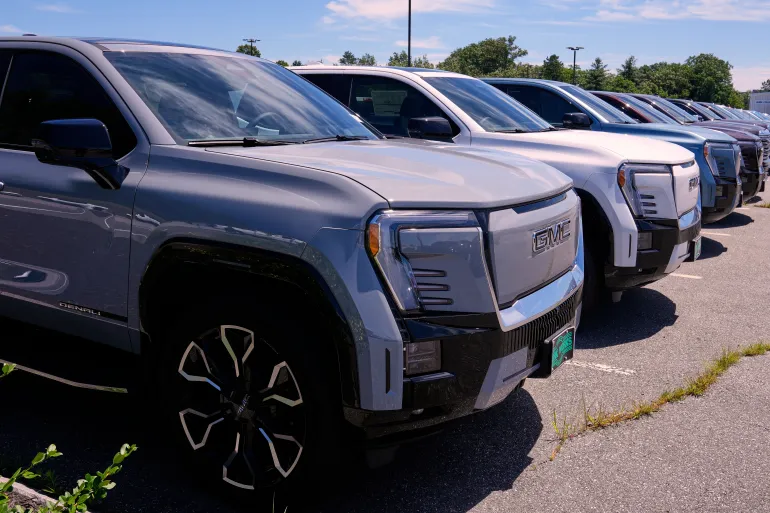China’s EVs dominate the world — why not in the US and Canada? | Explainer News
One month before he opened this year’s United Nations climate summit, Brazilian President Luiz Inacio Lula da Silva helped open a new mega-factory at the site of a former Ford car manufacturing plant.
The new plant, in Brazil’s Camacari, Bahia, is one of many being built around the world by China’s BYD, the world’s largest manufacturer of electric cars.
Recommended Stories
list of 4 itemsend of list
BYD’s presence is also being felt at the ongoing COP30 climate summit in Brazil’s Belem, where it is a cosponsor alongside GWM, another Chinese electric carmaker.
The sponsorship is just one of many ways that China’s investments in green technology are being felt at the UN’s top climate meeting, where the Chinese official delegation of 789 people is second only to Brazil’s 3,805.
It is a stark contrast to the United States, whose federal government has not sent an official delegation. California’s Governor Gavin Newsom has accused US President Donald Trump of “handing the future to China” and leaving states like California to pick up the slack, in a speech at the summit.
“ China is here. Only one country’s not here: United States of America,” Newsom said. Trump has called concerns over climate change a “hoax” and a “con job”.
But the UN Climate Change Conference COP30 is not the only event where the diverging paths that China and the US are taking on addressing the climate crisis are being felt.
Back in the US, and in neighbouring Canada, trade barriers aimed at punishing Chinese electric vehicles have made them far costlier than what the manufacturers want to sell them for.
These tariffs are a legacy of former US President Joe Biden’s administration, and place North America as an outlier at a time when Chinese EVs otherwise dominate the global market.
How dominant is China in EVs?
Joel Jaeger, a senior research associate with the World Resources Institute, told Al Jazeera that Chinese EVs have “really upended the car market” in recent years.
China has gone “from basically not a major player five years ago” to becoming “the number one exporter of cars globally in terms of the units”, says Jaeger.
According to the International Energy Agency (IEA), China manufactured 12.4 million electric cars in 2024, more than 70 percent of the 17.3 million electric cars manufactured globally last year.
Of these, China exported about 1.25 million cars, representing 40 percent of global exports, while the remaining Chinese-made cars — the vast majority — were sold domestically.
This dominance has been built on the back of “subsidies that China’s put in place to develop its industry, which I think is a very strategic thing that China has done, both for its own economic growth as well as decarbonisation”, Jaeger said.
But on the streets of the US or Canada, Chinese EVs are still relatively rare.
Why are Chinese EVs less affordable in the US and Canada?
According to Jaeger, “prohibitive” tariffs mean that Chinese EVs are almost impossible to buy in the US and Canada.
“In the last year, the US and Canada both put on basically completely prohibitive tariffs on EVs [of] over 100 percent in both places,” he added.
Notably, the steep import taxes on Chinese EVs in the US were introduced under Biden, a Democrat, who championed renewable energy, in contrast to Trump, who has pledged to fight it and “drill, baby, drill” for oil.
A month after the US introduced 100 percent tariffs on Chinese EVs in September 2024, Canada brought in identical tariffs of its own.
It means that a car that a Chinese EV manufacturer might be selling at $30,000 actually costs at least $60,000 in the US or Canada. This makes it hard for even cheaper Chinese models to compete with the higher-end US electric models, which on average retail for approximately $55,000.
These tariffs, along with other US policies, have meant that Chinese manufacturers have yet to set up shop in the US.
In Canada, Addisu Lashitew, an associate professor of business at McMaster University, told Al Jazeera that the steep tariffs conflict with targets set to transition fully to electric cars by 2035, but are also complicated due to Canada’s close trading ties with the US.
“The problem is that one, we are going through a very complex trade talk with the US now,” said Lashitew. “And two, our supply chain has also [been] very much integrated. Many of the American manufacturers are here, and Canadian firms are mainly suppliers.”
But while it is almost impossible to buy a cheap Chinese electric car in the US, Jaeger says this does not mean that North America is completely missing out on importing new Chinese technology.
“The US, for example, imports a lot of batteries from China. It’s actually the second-biggest importer of lithium-ion batteries behind Germany in the world, from China. So, they’re using them in US-made EVs,” he said.

Where can you buy cheap Chinese electric cars?
In contrast with the US and Canada, said Jaeger, many other countries have been more open to China’s EV market.
“You see different reactions from different countries, depending on their relationship with China, but mostly depending upon their domestic auto manufacturing presence,” he said.
Lashitew told Al Jazeera that Chinese exporters, including BYD as well as some smaller firms, are “targeting many emerging and developing countries”.
“Ironically, we’re in a situation where in the transportation sector, the energy transition is happening much faster in the Global South than in North America, at least.”
Chinese electric cars have also continued to sell well in many European countries, says Jaeger, despite those countries also imposing some tariffs, though lower than the US and Canada, “for what they see as unfair competitive practices in China”.
Still, while BYD has built factories in Japan, Hungary and India, as well as Brazil, its biggest presence remains in China, where the company was founded in Shenzhen in 1995. A majority of the 4.27 million electric cars that BYD sold in 2024 were bought by Chinese consumers. BYD also has a manufacturing presence in Lancaster, California, where it builds electric buses and batteries, but not cars.
In China, the local market has grown in part due to incentives from the government, which also saw electric cars as part of its strategy to bring down air pollution in big cities like Beijing and Shanghai.
Customers in China have benefitted from the government’s approach, including through access to new technology. For example, a new battery, which BYD announced in March with the promise of charging for 400km (about 250 miles) of travel in just five minutes, is first being made available for preorder to customers in China only.
How expensive are EVs?
They used to be costlier than cars that run on petrol or diesel. But according to the IEA, the cost of owning an electric car over the vehicle’s entire lifetime is now less than fossil fuel-powered cars, due to the reduced costs of fuel and maintenance.
Buying an electric car is still often more expensive, though.
That is where China’s subsidies to manufacturers help. The IEA has found that prices for electric cars in China are similar to petrol and diesel cars, with half of all electric cars being sold for less than $30,000 and a wide range of lower-priced models available.
By contrast, in the US and Europe, “the range [of available EVs] was skewed towards higher-end models with higher prices”, according to the IEA.
Under Biden, the US tried to boost its domestic electric vehicle industry, while also trying to get the sector to reduce dependence on China.
Biden’s Inflation Reduction Act (IRA) introduced incentives for US manufacturers that did not use any Chinese parts. The IRA also introduced subsidies for consumers who bought EVs, though these have largely been overturned by Trump’s Big Beautiful Bill, which became law in July.
Nevertheless, even with the Biden-era incentives, only one in 10 cars sold in the US in 2024 was electric, while more than half of all new cars sold last year in China were electric.

Not just cars
While electric cars grab most headlines on sustainable transport, people are also increasingly turning to electric bicycles, scooters, motorcycles, buses and even trains in many parts of the world.
Even in the US, says Jaeger, there has been a significant growth in the number of electric scooters and two-wheelers imported from China.
According to data from the Observatory of Economic Complexity (OEC), the US imported $1.5bn worth of electric two-wheelers from China in the 12 months up to September 2025, an increase of $275m — or more than 20 percent — from the previous year. Experts say that is because scooters are cheaper than cars, and because US tariffs on Chinese electric scooters are also lower than on electric cars.
Meanwhile, in Vietnam, the government has said it will ban petrol-powered motorbikes in the centre of its capital, Hanoi, from July next year, as part of a plan to tackle local air pollution.
According to the IEA, some 40 percent of bus sales are now electric in European countries, including Denmark, Finland, the Netherlands and Norway.
There have also been increases in electric bus sales in Central and South America. In Mexico, for example, “close to 18 percent of all bus sales were electric in 2024, up from just above 1 percent in 2023”, according to the IEA.
Still, the US continues to struggle here, too. Electric bus sales declined in 2024, according to the IEA, after the leading electric bus manufacturer went bankrupt and a second company stopped manufacturing in the US market after suffering sustained financial losses.
